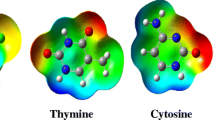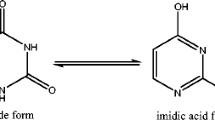Abstract
For in silico drug protein–nucleic acids interaction studies, the change in thermodynamic parameters plays an important role, specifically for deriving QSAR equations. The present study is a step towards finding new thermodynamic descriptors. The characteristic changes in physico-chemical properties of uracil and its corresponding nucleoside–uridine, components of RNA, with urea having –CO–NH– function typical of proteins in the presence of alkali metal ions (Na+, K+ and Ca++) have been studied using ultrasonic, volumetric and viscometric techniques. Density, viscosity and ultrasonic velocity of the solutions of base/nucleoside and urea (10−4 mol l−1) in presence of salt solution (in the range 0.1–0.5 mol l−1) have been measured. The thermodynamic parameters have been deduced from the experimental data. This study has highlighted the role of the thermodynamic parameters in ligand–nucleic acid interactions at the molecular level.
Similar content being viewed by others
References
Pandey JD, Haroon S, Dubey KK, Upadhyaya M, Dey R, Misra K (2000) Interaction of 6-aminopurine (adenine) in water and aqueous urea solutions. Can J Chem 78:1561–1569
Rodgers MT, Armentrout PB (2000) Non covalent interactions of nucleic acid bases (uracil, thymine and adenine) with alkali metal ions. Threshold collision-induced dissociation and theoretical studies. J Am Chem Soc 122:8548–8558
Meyer M, Suhnel J (2003) Interaction of cyclic cytosine, guanine, thymine, uracil and mixed guanine–cytosine base tetrads with K+, Na+ and Li+ ions—a density functional study. J Biomol Struct Dyn 20:507–517
Swiatek J (1994) Interaction of metal ions with nucleic acids and their subunits. An electrochemical approach. J Coord Chem 33:191–217
Costa M, Heck JD (1984) Metal ions in biological systems, vol 20. Marcel Dekkar, New York, pp 259–278
Luisi BF, Xu WX, Otwinowski Z, Freedman LP, Ymamoto KR, Sigler PB (1991) Crystallographic analysis of the interaction of the glucocorticoid receptor with DNA. Nature 352:497–505
Steitz TA (1993) Structural studies of protein–nucleic interaction. Cambridge University press, Cambridge
Barton JK (1994) Metal/nucleic acid interactions. Bioinorganic chemistry. University Press, Mill Valley, pp 455
Hong J, Capp MW, Anderson CF, Saecker RM, Felitsky DJ, Anderson MW (2004) Preferential interactions of glycine, betaine and of urea with DNA: implications for DNA hydration for effects of the solute on DNA stability. Biochemistry 23:14744–14758
Eli P, Ariyama T, Nishigaki K, Husimi Y (1999) Characterization of imidazole as a DNA denaturant by using TGGE of PCR products from a random pool of DNA. J Biochem 124:790–794
Pandey JD, Haroon S, Chhabra J, Dey R, Misra K (2005) Effect of Na+, K+ and Ca2+ Ions on physico-chemical properties of thymine, cytosine, thymidine and cytidine in aqueous urea solution. Chin J Chem 23:157–1164
Pandey JD, Jain P, Vyas V (1994) Speed of sound, viscosity and refractive index of multicomponent systems: analysis of experimental data from the Bertrand–Acree–Burchfield equation. Can J Chem 72:2486–2492
Pandey JD, Dubey N, Dwivedi DK, Dey R (2001) Prediction of heat of mixing from internal pressure data. Phys Chem Liq 39:781–790
Suryanarayana CV (1986) Measurement of internal pressure in liquid systems. Indian J Chem Sec A 25A:538–540
Gills EA, Rajabi K, Firdgen TD (2009) Structures of hydrated Li+–thymine and Li+–uracil complexes by IRMPD specroscopy in the N–H/O–H stretching region. Phys Chem A 113:824–832
Ghosh P, Mukhopadhyay TK, Sarkar AR (1984) Interaction of divalent metal ions with Uracil III. Complexes of MnII, FeII, CoII, NiII, CuII with Uracil acting as bidentate ligand. Transition Met Chem 9:46–48
Liu H, Sun JL, Hua YH, Han Ke-Li, Yang S (2004) Photodissociation of gaseous metal ion-nucleobase complexes: Mg+–uracil and Mg+–thymine. Chem Phys Lett 389:342–347
Hedwig GR (2006) Isentropic and isothermal compressibilities of the backbone glycyl group of proteins in aqueous solution. Biophys Chem 124:35–42
Author information
Authors and Affiliations
Corresponding author
Rights and permissions
About this article
Cite this article
Srivastava, T., Pandey, A., Sethi, R. et al. Interaction of Uracil and Uridine with the Cosolvent and Denaturant Aqueous Urea at Molecular Level: Effect of Na+, K+ and Ca++ Ions. Proc. Natl. Acad. Sci., India, Sect. A Phys. Sci. 82, 179–186 (2012). https://doi.org/10.1007/s40010-012-0017-9
Received:
Revised:
Accepted:
Published:
Issue Date:
DOI: https://doi.org/10.1007/s40010-012-0017-9




